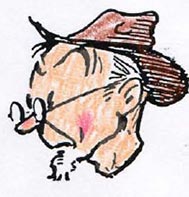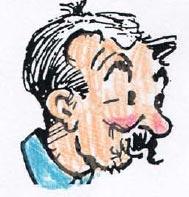|

This story was published in Radio Recall, the journal of the Metropolitan Washington Old-Time Radio Club, published six times per year.
Click here to return to the index of selected articles.
|
|
 DEVELOPMENT OF THE RADIO SITCOM DEVELOPMENT OF THE RADIO SITCOM
by Elizabeth McLeod © 2009
(From Radio Recall, February 2010)
Since it's important to define terms, we can define a "sitcom" as a program usually heard in a weekly half-hour time slot, dealing with continuing characters in humorous situations. The episodes are essentially self-contained, and although some plot threads may continue from episode to episode the program does not depend on a continuing serial story line for its appeal.
 |
That being so, I don't consider Sam and Henry or Amos 'n' Andy to be "the first sitcom," although Correll and Gosden did lay the foundation for the form. They were the first radio performers to present an ongoing dramatized series dealing with continuing characters as opposed to an anthology program.
Some of their situations were humorous -- and in fact Correll and Gosden were the first performers on radio to do character/situation based humor as opposed to joke comedy. But the comedy was mixed with an equal portion of straight drama, presented in a continuing serial format. |
Though it wasn't a true sitcom until the switch to a half-hour format in 1943, the success of S&H/A&A proved that listeners would follow characters on radio as opposed to simply listening to strings of jokes, musical selections, or anthology plays -- and this laid the groundwork for every character-based radio program that would follow. They were the seed, not just for sitcoms, but for the entire "OTR Era."
During 1928-29, the success of S&H/A&A inspired a number of continuing-character programs on the networks and on local stations. Some of these copied the A&A nightly 15-minute serial format (Cecil & Sally, Louie's Hungry Five, Luke & Timber, Lem and Lafe, Honeyboy & Sassafras, etc.) but others took the form in another direction. The Smith Family, on WENR, Chicago, was a weekly half-hour serial dealing with both humorous and dramatic themes in much the same manner as A&A.
The program, created by writer/producer Harry Lawrence is best remembered as an early vehicle for Jim and Marian Jordan -- but they did not appear as a couple in the series. Marian played Nora Smith, a middle-aged Irish housewife, opposite Arthur Wellington as her husband Ed Smith. The Smiths had two daughters, Betty and Irene -- and Irene's boyfriend was a small-time Irish prizefighter named Joe Fitzgerald, played by Jim Jordan.
The plots dealt primarily with the romantic entanglements of the Smith daughters, and is best described as a working-class One Man's Family rather than a sitcom -- although it was certainly another step along the road. Note: many published sources date this series to 1925 -- but this is an error dating back to a Radio Guide article published in the early 1940s and picked up by many writers since. The series actually began on 2/20/29.)
There were a number of network programs in the 1928-29 period which also fall into the evolutionary progression toward the sitcom format.- Real Folks and Mountainville Sketches were weekly half-hour programs, but the A&A influence of a serial story line overshadowed their humorous elements. Soconyland Sketches was primarily an anthology series (it didn't permanently become Snow Village Sketches with continuing characters until 1937) but its use of humorous scripts as opposed to straight drama places it along the sitcom progression.
Raising Junior was a nightly comedy/drama serial dealing with a middle-class couple and their two-year-old son and was notable as one of the earliest such programs not to incorporate ethnic or dialect elements.
All of these ingredients came together in September 1929 for the program which I consider the first "true sitcom." Mr. and Mrs. was a weekly self-contained half hour based on the comic strip created by Clare Briggs, and dealt with humorous incidents in the lives of the Greens, Joe and Vi, a middle-class, middle-aged, childless married couple. They spent most of their time fighting; typical of 1920s humor, the comic strip was a bitter, cynical affair. Joe and Vi could barely stand the sight of each other, spat venom in every conversation, and stayed married out of sheer inertia more than anything else.
By all accounts the radio series duplicated this tone quite closely. While the dialogue wasn't as poisonously exaggerated as The Bickersons would be in later years, the Greens were often referred to in reviews and publicity articles as "radio's battling couple" or other such combative descriptions. The series ran on CBS for the Graybar Electric Company for two seasons, and Joe and Vi were played by Jack Smart (yes, the Fat Man) and Jane Houston.
Publicity photos usually showed Smart and Houston done up to look like Joe and Vi -- which was quite an accomplishment, since Briggs drew Joe's head in a scratchy, harsh, flattened manner that made it look a bit like the crushed end of an old cigar butt. Smart would pose for these photos in a bald cap, a scribbly-looking false mustache, and nose glasses, with his faced compressed into an expression of utter misery. Houston would usually be standing next to Smart, arms akimbo, giving him a cold, fish-eyed glare. This, at last, was a pure sitcom.
However, Mr. and Mrs. did not spark a rash of imitators. The year 1932 saw the invasion of radio by vaudeville and musical-comedy performers, and the sitcom idea was shunted aside. There were a few experiments during the Thirties -- Jack Pearl's Peter Pfeiffer in 1934, Gertrude Berg's House of Glass in 1935, and Snow Village Sketches in 1937.
The most successful move in the sitcom direction was Fibber McGee and Molly in 1935. This program was very loosely constructed, and had as much in common with the vaudeville and minstrel tradition as it did with sitcom technique. Much of the dialogue was simple setup/punch line humor that could just as easily have been delivered by Tambo and Mr. Bones.
The Forties saw the sitcom format really come into its own; The Aldrich Family in 1939 was the leading edge of this wave, and by the early Forties, sitcoms had really caught on. By the end of that decade, they were a dominant format, and as such, carried over into television.
When Burns and Allen converted from a vaudeville-influenced variety format to a sitcom in 1942, they were following a trend rather than creating one. Likewise when Correll and Gosden finally bowed to the inevitable in 1943 and turned Amos 'n' Andy into a sitcom, they were following rather than leading.
It's important to note, as an aside, that the roots of the sitcom are not exclusively based in radio. In the 1920s and 1930s, a number of comedians were filming continuing series of movie shorts that were indisputably situation comedies. Max Davidson's silent shorts dealing with humorous aspects of Jewish ghetto life, Charley Chase's middle-class comedies-of-manners, Edgar Kennedy's The Average Man series, Leon Errol's jolly-alcoholic comedies, and much of Laurel and Hardy's work are the best examples. It is quite likely that these influenced the development of the form in radio, and certainly later in television.
Editor’s Note: This was originally posted on the Old Time Radio Digest. It is published here with the specific permission of the author.
|